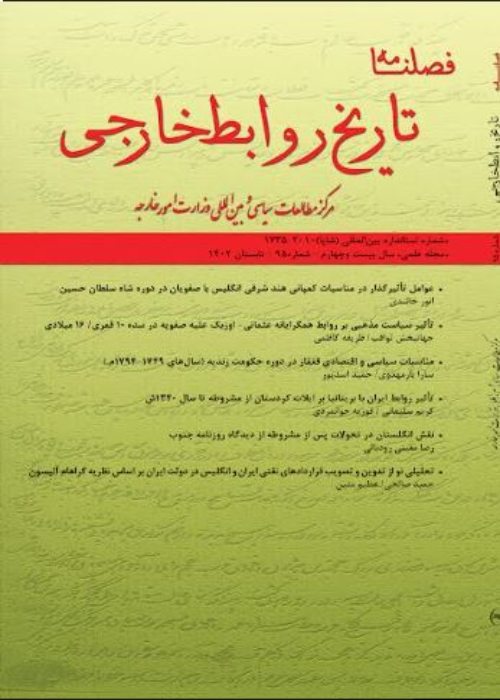The Social and Legal Status of Iranians Living in the Ottoman Empire in the 11th and 14th Centuries AH, with Emphasis on Iraq
Author(s):
Abstract:
The first Iranian inhabitants of Anatolia date back to the establishment of the Ottoman state in the 14th century. After the Safavid-Ottoman battles which resulted in the annexation of the Arabic territories to the Ottoman Empire, there was a rise in the number of the Iranians who went on pilgrimage to Iran and Hejaz. Since the beginning of the 18th century and in the wake of Iran-Ottoman bloody battles, trade obstacles were removed and the trade routes, which had been barred for more than two centuries, were opened. As a result, the majority of Iranian merchants used Asia Minor trade routes instead of those in the Persian Gulf and Russia. The trade activities through Asia Minor routes made the intermediary merchant settle in the Ottoman Empire.From the very beginning, the Iranian community living in the Ottoman Empire was at odds with the policies exerted by the Ottoman rulers. During the Safavid dynasty, the hostility between the two countries was reflected in the status of Iranian community living in the Ottoman territory. During the rule of the Qajars, the rights of Iran as an Islamic country was recognized semi-officially in the Ottoman Empire, a situation which had a huge impact on the Iranian diaspora in the Ottoman territories.Perusing the huge amount of documents pertaining to that era, its seems that Iranian community in the Ottoman Empire was mainly exposed to the following difficulties: 1- excruciating unfair taxes on Iranian pilgrims in the Ottoman territoty, 2- imposing a ransom (Jazzieh) on Iranians who were considered among the ‘Zemme’ community, 3- expropriation of the deceased Iranians in the Ottoman territory, 4- Issuing decrees on inviting the Iranians to the Asgari sect, 5- banning the marriage of Iranian men to Ottoman women. The paper seeks to assess the five axes mentioned above through referring to Iranian and Ottoman resources and authentic resources and analyze the Ottoman policy towards these issues and finally study the impact of Iran-Ottoman relations on the Iranian diaspora in Istanbul.
Keywords:
Iran , Ottoman , Iranian Immigrants , Social , Legal Status
Language:
Persian
Published:
History of Foreign Relations, Volume:13 Issue: 52, 2013
Page:
13
magiran.com/p1241327
دانلود و مطالعه متن این مقاله با یکی از روشهای زیر امکان پذیر است:
اشتراک شخصی
با عضویت و پرداخت آنلاین حق اشتراک یکساله به مبلغ 1,390,000ريال میتوانید 70 عنوان مطلب دانلود کنید!
اشتراک سازمانی
به کتابخانه دانشگاه یا محل کار خود پیشنهاد کنید تا اشتراک سازمانی این پایگاه را برای دسترسی نامحدود همه کاربران به متن مطالب تهیه نمایند!
توجه!
- حق عضویت دریافتی صرف حمایت از نشریات عضو و نگهداری، تکمیل و توسعه مگیران میشود.
- پرداخت حق اشتراک و دانلود مقالات اجازه بازنشر آن در سایر رسانههای چاپی و دیجیتال را به کاربر نمیدهد.
In order to view content subscription is required
Personal subscription
Subscribe magiran.com for 70 € euros via PayPal and download 70 articles during a year.
Organization subscription
Please contact us to subscribe your university or library for unlimited access!


